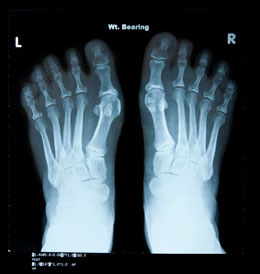Bone spurs are bony outgrowths or projections that generally develop in the knees, feet, hands, as well as in the shoulders and spine. Find out more about the causes, as well as the symptoms and treatment of this condition, through this Buzzle article.

Bone spurs or osteophytes are bony outgrowths that usually develop in the joints. They can also be found in those areas where ligaments or tendons meet the bones. Osteophytes are usually caused when one bone rubs against another bone. Like any other tissues, bones are also subjected to constant wear and tear due to pressure, rubbing, or stress, and they are also renewed almost every five years. But sometimes, in this process, extra bones are built on the edges of the existing bones. Though osteophytes can occur anywhere, they are more commonly found in places like the spine, shoulders, hands, hips, feet, and the knees.
Causes of Bone Spurs
Several factors can play an important role in the formation of osteophytes. Sometimes, they can be a result of the natural aging process, while at other times they can be associated with certain diseases like osteoarthritis. Osteoarthritis causes the breakdown of the cartilage of the joints. Cartilage is a type of connective tissue that covers the edges of the bones in a joint. It prevents one bone from rubbing against another.
So, when cartilage wears away due to osteoarthritis, the bones start to rub against each other. Our body tries to form new bones in response to this stress, leading to the formation of osteophytes. Another condition associated with osteophytes is plantar fasciitis. The plantar fascia is the long ligament located at the bottom of the foot. An inflammation of this ligament is known as plantar fasciitis, which is generally caused by activities that put excess stress on the feet. Sometimes, this condition can be caused by the habit of wearing tight shoes. An irritation or inflammation of the plantar fascia often results in the formation of osteophytes.
Spondylosis, a degenerative arthritis, can cause deterioration of the bones of the neck and the lower back region. This can also cause the development of osteophytes in those areas. Diffuse idiopathic skeletal hyperostosis (DISH) can cause osteophytes in the ligaments of the spine. Sometimes, osteophytes may not be related to any disease. Rather, they can develop due aging. They have been found in certain elderly people even in the absence of osteoarthritis. So, it is presumed that our body may form osteophytes to provide more stability to the aging joints, or to prevent damage to the cartilage.
Symptoms of Bone Spurs
Osteophytes are usually smooth, and they do not produce any symptoms. But one can experience pain and swelling, if they are pressed, or if they rub against other bones or tissues. Depending on the location of the osteophytes, the symptoms can vary considerably. You may find difficulty in bending and extending your leg, and knee pain, if they are formed in your knee joint. They can restrict the movement of the hands, if they occur on the shoulder. On the other hand, if osteophytes have developed in the neck region, they can make it difficult to swallow and breathe properly.
Treatment of Bone Spurs
Osteophytes are usually detected in X-rays done for other conditions. They usually do not require any treatment unless they are painful, or when they restrict the movement of a particular joint. If pain and swelling are present, then non-steroidal anti-inflammatory drugs can be recommended by physicians.
Sometimes, osteophytes are caused by excess body weight, as extra weight can put more pressure on the joints. So, it is important to maintain an ideal body weight to prevent or manage this condition. In certain instances, bone spurs have been observed to get dislodged from the edge of the original bone. Such separated osteophytes can float in the joint and cause joint locking. If joint locking restricts movements, then surgery may be required.
Though osteophytes usually do not cause any major problem, they can severely limit motion by causing joint interlocking. In order to prevent such complications, it is better to remain vigilant against the disease by avoiding activities that place more pressure and stress on the joints.
Disclaimer:
This article is for informative purposes only, and should not be treated as a substitute for professional medical advice.


 Bone spurs or osteophytes are bony outgrowths that usually develop in the joints. They can also be found in those areas where ligaments or tendons meet the bones. Osteophytes are usually caused when one bone rubs against another bone. Like any other tissues, bones are also subjected to constant wear and tear due to pressure, rubbing, or stress, and they are also renewed almost every five years. But sometimes, in this process, extra bones are built on the edges of the existing bones. Though osteophytes can occur anywhere, they are more commonly found in places like the spine, shoulders, hands, hips, feet, and the knees.
Bone spurs or osteophytes are bony outgrowths that usually develop in the joints. They can also be found in those areas where ligaments or tendons meet the bones. Osteophytes are usually caused when one bone rubs against another bone. Like any other tissues, bones are also subjected to constant wear and tear due to pressure, rubbing, or stress, and they are also renewed almost every five years. But sometimes, in this process, extra bones are built on the edges of the existing bones. Though osteophytes can occur anywhere, they are more commonly found in places like the spine, shoulders, hands, hips, feet, and the knees.